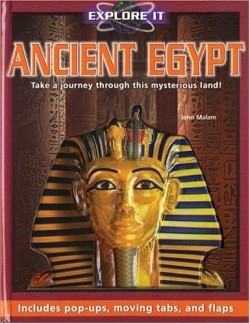Ancient Egypt
Egyptian cargo boats, ancient pyramids, and erupting volcanoes spring from the pages in these new pop-up books, part of the publisher’s “Explore It” series. The subjects of the books come to life and offer readers aged ten and up a concrete, interactive way to investigate topics that can seem abstract in traditional textbooks.
Ancient Egypt takes the reader back in time more than 3,000 years with colorful illustrations, short blocks of text, and well-planned objects that pop, pull, flip, and fold. The book explores the aspects of Egyptian culture that children would be most curious about. Themes include family life, children’s appearance and dress, toys and games, and mummies. Kids will be surprised by the “sidelocks” hairstyle—single pigtails on an otherwise shaven head, that children wore. They are invited to spin the wheels on a pop-up chariot driven by men outfitted in period battle gear, and take a glimpse inside a typical home by pulling a tab to reveal sparse furniture, white-washed clay walls, and a statue of the god Bes, the protector of homes.
The author is an archaeologist and historian who has written more than 150 non-fiction books for children, including The Ultimate Book of Dinosaurs and several others on ancient Egypt, like Mummies: And the Secrets of Ancient Egypt and Ancient Egyptian Jobs.
Here, the text is delivered in the voice of a different Egyptian god or goddess for each topic. Osiris, the god of vegetation, presents information about the farming cycle and typical crops. The year is depicted divided into an illustrated wheel so children can visualize the floods that fertilized the plains each year and the way livestock was used to plant seed and harvest the crops. The goddess of justice, Maat, tells the reader about the legal system and ancient punishment; how execution was the price for tomb robbery and murder, and theft was punished by “100 strokes of the cane.” Unfamiliar words, like “barter” and “papyrus,” appear in bold print and are defined in the glossary on the book’s last page.
In Earthquakes and Volcanoes, young readers learn about the causes of these natural phenomena and the effects they have on the earth as well as on people and cities. The photographs, illustrations, and text demonstrate for children that earthquakes and volcanic eruptions have occurred throughout history as the earth shifts and changes.
This author holds a Ph.D. in English from Trinity College at Cambridge. She has written more than twenty-five children’s books on computers, science, and history; including a “Cities Through Time” series and The Encyclopedia of the Middle Ages.
Earthquakes and Volcanoes begins with an explanation of the earth’s liquid core, tectonic plates and fault lines, and stories of quakes and volcanoes on Mars, Venus, and one of Jupiter’s moons. To understand the causes of volcanoes, readers can glance inside the earth at the liquid that makes up the mantle, the outer core, and the inner core. They can pull a tab to shake a city block, replicating the effects of a tremor.
The most impressive pop-ups here are those showing active, erupting volcanoes. Readers learn about Dante II, a robot built to research volcanoes from the inside, and Paricutin, a volcano in Mexico that grew from a field into a cinder cone within months. On these pages, children can pull a pop-up so it grows from a mountain into a fire-spewing volcano.
The last pages feature drawings and descriptions of the most disastrous earthquakes in history, a short reading quiz, and an index that defines words like “magma” and “seismic wave.”
Small hands and inquisitive minds will find much to entertain and instruct within these pages. In a school or library, these volumes will inspire and encourage curiosity.
Reviewed by
Whitney Hallberg
Disclosure: This article is not an endorsement, but a review. The publisher of this book provided free copies of the book to have their book reviewed by a professional reviewer. No fee was paid by the publisher for this review. Foreword Reviews only recommends books that we love. Foreword Magazine, Inc. is disclosing this in accordance with the Federal Trade Commission’s 16 CFR, Part 255.

